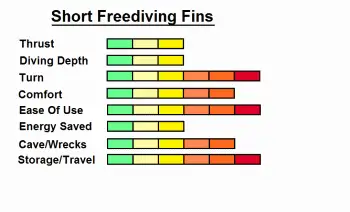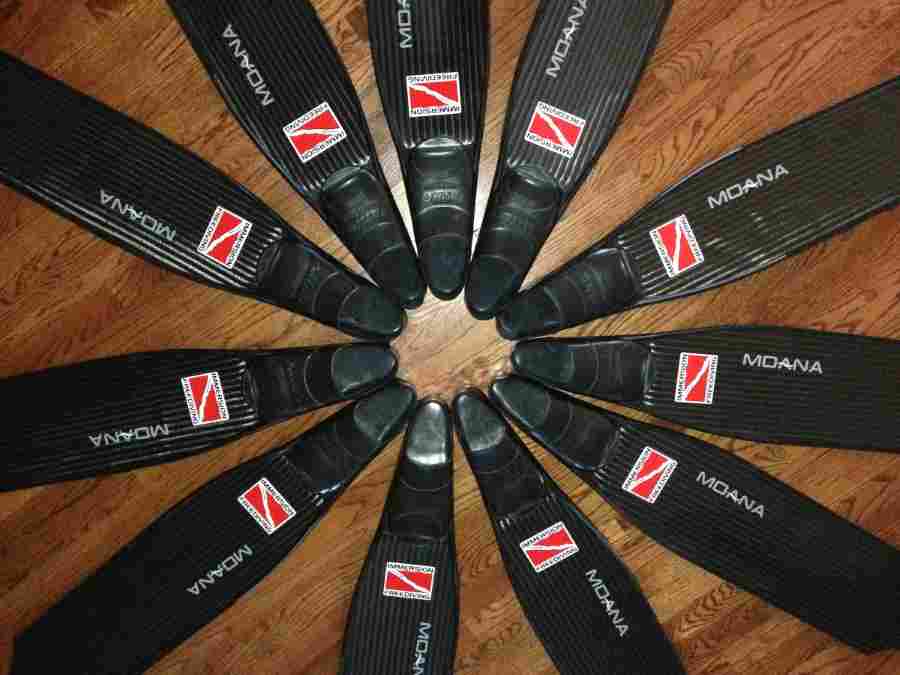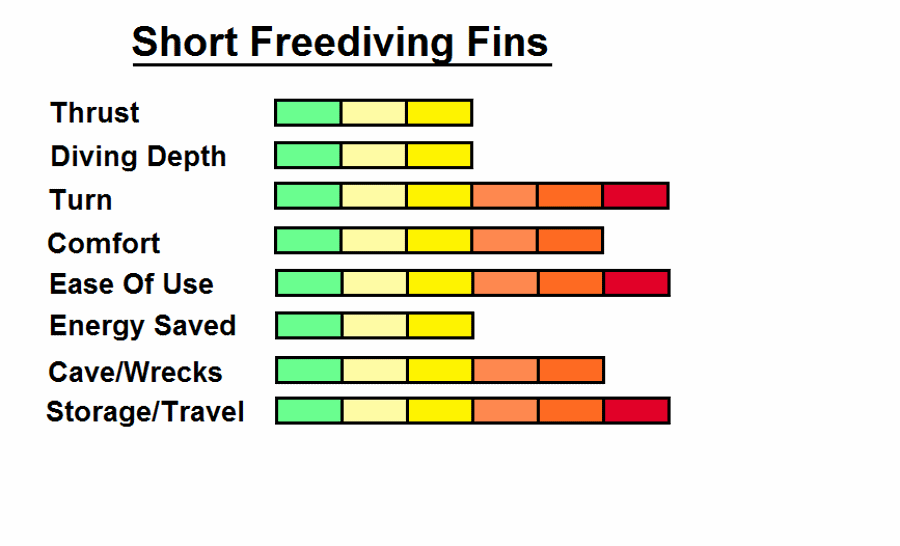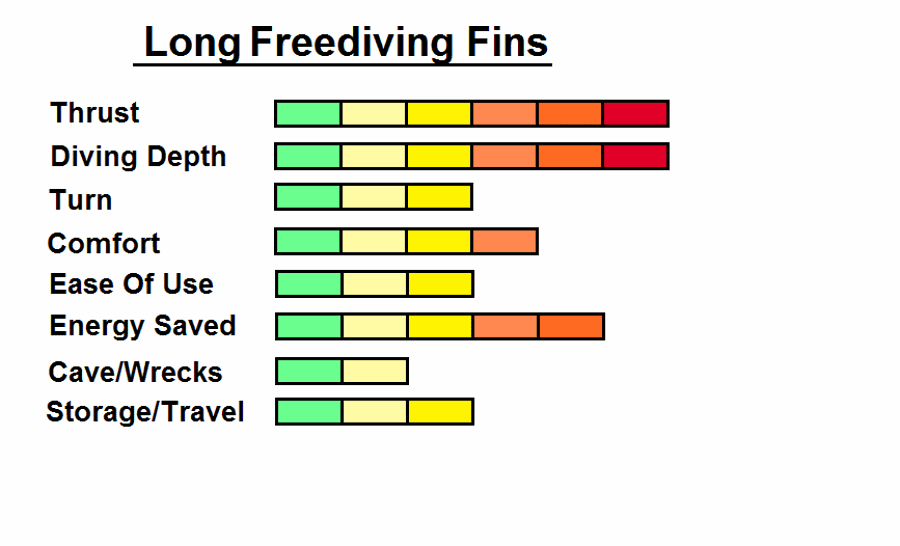- You are here:
- Home »
- Blog »
- Gear Guide »
- Why Are Freediving Fins So Long?
Why Are Freediving Fins So Long?

If you look at your average freediver you’ll notice they have much longer fins than what is used for snorkeling, swimming or even scuba diving.
And if you’ve ever tried wearing long freediving fins, you’ll agree that walking on land with them feels absolutely ridiculous and can be a huge hassle.
So why are freediving fins so long? And do you need them for deep freediving?
Freediving fins are so long because longer blades displace more water per kick. This means overall you use less energy per kick. This highly efficient tweak to your fin blade length means you’re able to propel yourself through the water rapidly, covering more distance using less time, oxygen and energy.
Less input, for more output.
Longer freediving fin blades, will in the long run, result in more oxygen being saved for your brain & body so you can dive deeper, for longer.
If you’d like to find out what the best long-bladed freediving fins are for beginners; then click here to read my post about the Gara LD Professional bi-fins. (these fins will easily and almost instantly add another 25 – 35 ft of depth to your freedives)….

Some long freediving fin blades can be more than 40 inches (101.6 cm) long!
How long are freediving fins?
Standard long freediving blades are about 31.5 (80cm) – 38.5 inches (~98 cm) long. This does not include the foot pocket at the base of the blade.
How to travel with freediving fins
Long fins can make travelling and storage a hassle.
Most long fins won’t fit into standard length bags or even suitcases.
You only really have two options for travelling with long fins:
1) Use adjustable freediving fins. Adjustable fins let you screw the blade off to decrease the overall length of the fin. This makes packing easier.
2) Use a freediving fin bag that is specifically made for carrying long bladed fins. Proper freediving fin bags are often more than 40 inches long (so can fit almost any long freediving fins) and the bags are typically padded heavily on the inside (so your expensive fins don’t break during travels).
If you plan on flying and taking your long freediving fins with you; I strongly recommend investing in a freediving fin bag to protect your fins from airport security who tend to be quite rough with check-in luggage.
Also – don’t try to sneak your freediving fins onto a plane as carry-on luggage, as it’s illegal on most airlines and can result in your fins getting confiscated.
It’s much better to just invest in a freediving fin bag like the Beuchat Mundial fins bag (click here to check the price on Amazon) – it fits almost any long freediving fin and has plenty of pockets that can hold masks, passports, towels & clothes etc to really simplify you travelling experience.
Long vs short freediving fins
Long freediving fins give you more thrust, but also take more muscle power initially to propel you through the water.
Short freediving fins give you less thrust, but also need less muscle power to move you through the water.
So does that mean they cancel out and neither is better for conserving energy?
Not quite. Long fins are still preferred for freediving because they unlock more potential power with each kick. If you have strong leg muscles and use short fins your kicking power ‘caps out’ or plateaus. You don’t get the full underwater thrust return on your powerful leg muscles. In the long run, you lose more energy from frantic kicking.
Fin length is like a gear on a bike
Think of short fins like riding a bike in low to medium gear. Each peddle may be easier but you’ll also have to peddle more to cover more distance.
But if you have long freediving fins you’re in a higher ‘gear’ which means you tap into your full potential.
If you have strong legs you’ll unlock much greater thrust as you have a longer blade propelling you through water. When you’re pushing your potential limits, trying to reach deeper depths and shouldering more and more risk…do you really want to use a shorter, slower fin when you’re coming up from the bottom gasping for air?
In freediving mere seconds can be the difference between shattering a record…or blacking out underwater and losing your life to freediving.
In summary: Long freediving fins let you make a mad dash to the bottom and rush back up quickly all in one breath. They provide extra thrust when you need it, which is crucial in case of emergencies.
Short freediving fins: a closer look

(Short freediving fins are great for shallow cave dives and for travelling).
The diagram above is a good baseline guide for understanding short freediving fin strengths vs weaknesses.
Please do keep in mind that other things outside of fin length effect how good a fin is. For example: blade material, flexibility, foot enclosures, ridge styles all matter.
Below is an explanation of the short freediving fin scores as shown in the diagram above:
Thrust (score = 3/6): Short fins give a huge thrust when compared to diving without fins. But when compared to long freediving fins, you’re leaving extra thrust and kicking power on the table. You’ll find your kicking technique to be more short and choppy, leading you to burn through energy reserves faster. Also, avoid using short fins in strong currents.
Diving Depth (score = 3/6): When you get passed the ~ 35 foot mark (about 10 meters deep), you become negatively buoyant and the ocean sucks you deeper and deeper. Therefore, the deeper you plan to dive, the more power you need to get on your side, to get back up to the surface – something short fins don’t offer.
Turn (score = 6/6): Short fins aren’t very long (obviously!). This means you can rapidly change directions easily. Without long blades you won’t have to worry about hitting things or experiencing extra drag as you re-position in the water. This makes for great turning ability to keep you nice and agile in the water.
Comfort (score = 5/6): The shorter blades make for a more comfortable experience in and out of the water…because you’ll be dealing with less weight and less drag when turning. Also, short freediving fins usually come with open heels. Open heels allow you to wear diving boots with full padded soles. This can be a nice and cozy fit, especially in cooler waters. If you’d like to read more about how open vs closed heel fins change your freediving performance, you can check out my post by clicking here.
Ease of Use (score = 6/6): Short freediving fins are very similar to any other normal fin you’d have used in the past eg: scuba, snorkelling fins etc. The technique you use is largely similar and intuitive, so you shouldn’t have much trouble using them. Also, these fins need less muscle to thrust you forward, so is a good option if you aren’t looking to build stronger legs.
Energy Saved (score = 3/6): Although each kick may be easier overall, jetting large distances rapidly while underwater with short fins will eat away at your energy and oxygen reserves. With short fins…your swimming speed is still in first gear, remember?
Caves/Wrecks (score = 5/6): Short fins are fantastic for exploring tight areas like caves, wrecks and coral-dense areas. You’ll have good enough thrust without having to worry about scraping or damaging your fins.
Storage/Travel (score = 6/6): As far as fins go, short freediving fins are a lot easier to transport with. They should fit in most traditional luggage and backpacks.
Long freediving fins: a closer look

(Long freediving fins lack maneuverability, but excel at thrusting you through the water).
Thrust (score = 6/6): Long fins give more thrust because they displace far more water per kick. You’ll find with longer blades you’ll adopt a slower, calmer kicking motion that propels you through the water.
Diving Depth (score = 6/6): When resurfacing from deep dives you’ll find the negative buoyancy pulls you back down into the depths. Having long fins with highly efficient blades will jet you to the surface rapidly making them great for deep dives.
Turn (score = 3/6): Long blades offer more drag and resistance to water because there’s a larger surface area catching more water. This means turning rapidly becomes quite difficult in long fins.
Comfort (score = 4/6): Most long fins come with fully enclosed foot pockets which can get a little cramped. To be safe, buy your long fins one size too big and then wear diving boots to fill the gaps so the fins fit snuggly. Also, the long blades may be a little uncomfortable at first, but once you get used to them you’ll be fine.
Ease of Use (score = 3/6): The long blades on freediving fins means you’ll take a while to get used to the new kicking technique. You’ll also struggle at first with kicks if you don’t have particularly strong leg muscles. The good news is eventually your leg muscles grow and get stronger so the fins become easier and more efficient to use.
Energy Saved (score = 5/6): Each kick may be harder to do, but overall you will save more energy if speed, thrust and distance is your goal. In terms of depth and oxygen saved; long fins are only trumped by one other fin…the monofin.
Caves/Wrecks (score = 2/6): It’s best to avoid cave and wreck diving with long freediving fins. The last thing you want to do is damage your fins. And this is a huge risk if you’re using carbon fiber fins with low stiffness.
Storage/Travel (score = 3/6): As powerful as they are, long freediving fins are not easy to store or travel with. You’ll likely struggle packing them into small to medium sized bags. If possible at all, try to get a fin bag or buy fins with removable blades and take them off when travelling to save space.
Long vs short freediving fins: conclusion
Hopefully the above answers your question as to why freediving fins are so long.
But just to be clear: you can still go freediving with short fins. It’s just that in most cases you’ll be sacrificing depth and underwater time for comfort and ease of use.
If you already have short fins and a low budget and just want to get started, go for it. If you end up really liking freediving, simply invest in some longer fins down the track.
Freediving fins vs scuba fins
Scuba diving fins are short (very similar to short freediving fins) because that’s what works best for scuba diving.
You see, when you go scuba diving, your gear already comes with a lot of underwater drag and resistance. On a 30-minute scuba dive; you’re lugging around a heavy oxygen tank, a breathing apparatus and more. The last thing you want to have to deal with are long freediving fins that require constant effort to propel you forward. It would simply be too much resistance over a long period of time and you’d tire out before everyone else.
That’s why scuba diving fins are built to be short and easy to use. With very little effort you can gently push yourself along at a constant, slow pace while observing the environment.
So when it comes to freediving: use long freediving fins; not scuba diving fins.
Now that you know what’s better out of freediving fins vs scuba fins, let’s take a look at the different materials used in freediving fins. Freediving fins generally come in three different materials: plastic, fiberglass or carbon.
Plastic freediving fins
When you kick using a long-bladed fin; the blade bends. The material in the blade then tries to straighten out again. When the blade straightens out again it snaps back into place which is what propels you through the water.
This is called a blades’ responsiveness and is what makes long fins so powerful. A blade’s responsiveness (power) is greatly affected by the material it’s built of. Plastic freediving fins have weak responsiveness. When you bend the blade, they slowly snap back into place, which makes for a weaker thrust.
This means you get less power per kick, when compared to fiberglass or carbon fins. Plastic freediving fins also lack flexibility. This means when you kick with them, the blade doesn’t bend much and remains quite rigid. This will cause more drag and spend more of your energy per kick for a weaker thrust.
On the plus side, plastic fins are the most affordable of the three fin types. And they are still fantastic for beginner freedivers and provide much more power than short fins.
For plastic/elastomer freediving fins, I strongly recommend the Gara LD Professional fins. Click here to view them on Amazon.
Fibreglass freediving fins
If you’ve used plastic freediving fins and decide to move on to fiberglass, you’ll notice the difference instantly.
Fiberglass freediving fins are more flexible and responsive than plastic. This means you’re kicking with a set of blades that spring back powerfully into place. The end result: you save energy and dive for longer. Note that fiberglass fins are more expensive than plastic, but more affordable than carbon fiber.
Carbon fiber freediving fins
Carbon fiber are tier one freediving fins. They are often used in times where divers need get to the surface quickly after incredibly deep dives.
Carbon fiber fins are incredibly flexible and hugely responsive. When you kick, the blade will bend more than 90 degrees and will rapidly snap back into place, jetting you through the water like a torpedo.
Using carbon fiber fins, you’ll typically conserve the most energy and be able to do the deepest dives when compared to the other two fin materials. It is important however, that you select fins which have a good stiffness.
And remember, investing in carbon fiber fins will not automatically make you a good freediver; only practice will. Note that carbon fiber is also the most expensive and isn’t recommended for beginners.
If you’re after a nice entry-level carbon fiber fin, I recommend the Leaderfins Pure Carbon Fiber Freediving Fins. They are incredibly flexible, lightweight and literally torpedo you through the water when you fin. Your jaw will drop when you see how powerful they are! 😉
How to kick with long freediving fins
The long blades of your freediving fins offer much more resistance when kicking. This makes kicking feel harder, making it more likely you’ll bend your knees when kicking to offset the extra resistance.
Therefore, it’s important when using long freediving fins to keep your legs straight. Your legs should be as straight as when you walk down the road on hard ground. Also, make sure you kick just as far in front of your body as you do behind. This may be a challenge at first, as your muscles aren’t used to it. But eventually you’ll build your leg muscles and glide through the water effortlessly.
Best freediving fins for beginners
As covered previously, long plastic freediving fins are better for beginners.
They are miles better than short freediving fins or snorkeling/scuba fins and come at an affordable price.
About the Author Gerrie van Niekerk - Apnealogy
Gerrie is a passionate Freediver, Spearfisher, Digital Marketer, and author for the Apnealogy website. Gerrie is an SSI Level 1 certified Freediver who loves geeking out about freediving and spearfishing gear and lives for his family and adventure.


